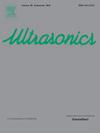Optimal design and experimental study on a novel relaxor ferroelectric single crystal transducer based on face shear vibration mode
IF 3.8
2区 物理与天体物理
Q1 ACOUSTICS
引用次数: 0
Abstract
The underwater acoustic transducer is an important component of underwater sonar detection equipment, but it has constraints in terms of wide bandwidth and small size. [011] The polarization direction and zxt-45° cut PMN-PT single crystal have the characteristics of high shear piezoelectric strain constant, high electromechanical coupling coefficient and high compliance coefficient. These advantages provide ideas for breaking through the limitations of traditional transducers in terms of wide bandwidth and small size. This paper mainly uses the face shear vibration mode of the single crystal and adopts the method of face shear vibration and longitudinal vibration coupling to broaden the working frequency band. First, the influence of structural parameters on the vibration mode and resonant frequency of each order mode is studied utilizing finite element simulation analysis. Secondly, the NSGA-Ⅱ optimization algorithm and the finite element method are used to optimize the face shear mode broadband transducer designed in this paper. Finally, a face shear single crystal longitudinal vibration transducer prototype was made and tested and analyzed. The transducer has an outer diameter of 75 mm, a length of 36 mm, an operating frequency band of 7 kHz–60 kHz, a maximum transmission voltage response of 127 dB, and an in-band transmission voltage response fluctuation of less than 4.6 dB. Therefore, the use of a new face shear mode is conducive to achieving small size, high power and broadband emission of the underwater acoustic transducer.
基于面剪切振动模式的弛豫铁电单晶换能器的优化设计与实验研究
水声换能器是水声呐探测设备的重要组成部分,但它存在带宽大、体积小的限制。[011]极化方向和zxt-45°切割PMN-PT单晶具有高剪切压电应变常数、高机电耦合系数和高柔化系数的特点。这些优点为突破传统换能器在宽带宽和小尺寸方面的限制提供了思路。本文主要采用单晶的面剪振动方式,采用面剪振动与纵向振动耦合的方法来拓宽工作频带。首先,利用有限元仿真分析研究了结构参数对结构振型和各阶振型谐振频率的影响。其次,采用NSGA-Ⅱ优化算法和有限元法对设计的面剪切型宽带换能器进行了优化。最后,制作了面剪切单晶纵向振动传感器样机,并对样机进行了测试和分析。换能器外径75mm,长度36mm,工作频带7khz - 60khz,最大传输电压响应127 dB,带内传输电压响应波动小于4.6 dB。因此,采用新的面剪切模式有利于实现水声换能器的小尺寸、高功率和宽带发射。
本文章由计算机程序翻译,如有差异,请以英文原文为准。
求助全文
约1分钟内获得全文
求助全文
来源期刊

Ultrasonics
医学-核医学
CiteScore
7.60
自引率
19.00%
发文量
186
审稿时长
3.9 months
期刊介绍:
Ultrasonics is the only internationally established journal which covers the entire field of ultrasound research and technology and all its many applications. Ultrasonics contains a variety of sections to keep readers fully informed and up-to-date on the whole spectrum of research and development throughout the world. Ultrasonics publishes papers of exceptional quality and of relevance to both academia and industry. Manuscripts in which ultrasonics is a central issue and not simply an incidental tool or minor issue, are welcomed.
As well as top quality original research papers and review articles by world renowned experts, Ultrasonics also regularly features short communications, a calendar of forthcoming events and special issues dedicated to topical subjects.
 求助内容:
求助内容: 应助结果提醒方式:
应助结果提醒方式:


